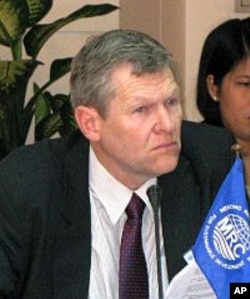Earlier this year, Laos submitted a proposal for a major Mekong River dam project that was the first of its kind among lower Mekong countries. But conservation groups fear that such a dam will hurt the environment and livelihoods of millions of people in the region and in Cambodia.
The Xayaburi dam project in Laos is the first of 12 dam proposals on the mainstream Mekong and has been very controversial because it will be the most important decision about the river in decades.
Aviva Imhof, campaigns director of International Rivers, says if the project is approved, it will encourage other projects, which together will have disastrous impacts on Cambodia’s fisheries and agriculture.
“The Xayaburi dam would be the first dam to be built on the lower Mekong mainstream so it is an extremely significant project, because if this project is approved then it will basically open the door for 11 other dams,” he told VOA Khmer recently.
The Xayaburi dam is planned in Laos’ northwestern Xayaburi Province, more than 1,000 kilometers upstream from Phnom Penh. The dam is expected to be 810 meters long and 32 meters tall, with a capacity of 1,260 megawatts. As proposed, it will interfere with the entire flow of the Mekong.
Experts say the further down on the Mekong that mainstream dams are built, the more fish migration and sediment flow it blocks. The nine proposed dam projects further downstream from Xayaburi also would destroy the livelihood of millions of people, groups fear. These include Cambodia’s own Strung Treng and Sambor dam proposals.
But Jeremy Bird, CEO of the Mekong River Commission, told VOA Khmer during a phone interview from Vientiane that it is premature to be overly concerned about the effects the Xayaburi plan since it may not be approved and because each project is considered on a case-by-case basis.
“I think it’s too early to say how that will be viewed by the joint committee in terms of the overall process and the agreement itself,” Bird said. “I think the likelihood of that happening is a small one.”
In a US Senate hearing earlier this year, civil society groups criticized the Lao submission ahead of the release of a major environmental assessment report as a “political move,” saying Laos was intentionally going ahead with the dam project.
The Strategic Environmental Assessment report commissioned by the MRC was publicly released three weeks after Laos’ official submission. It finds that each dam would block crucial fish migration, and together would have permanent damage on the river’s ecology. The report notes that for Cambodia, fisheries losses will outweigh energy production benefits. It recommends a 10-year deferral of all Mekong mainstream dams in Cambodia, Laos, Thailand, and Vietnam, and calls for further studies.
Officials at the Lao National Mekong Commission in Vientiane could not be reached for response to the criticisms.
But Bird says the delay of the release was only a technical problem and, although late, the release was in time for a major decision making process of the four countries that started in October.
“The Lao government was well aware of the timeframe of the [report] process,” Bird said. “It’s been involved right throughout the process in all the different workshops. And so the submission basically has come at the end of the [report] process.”
The submission of the dam triggered a six-month study, consultation, and decision process, at the end of which, in April 2011, Cambodia, Laos, Thailand and Vietnam are expected to reach an agreement on whether or not to allow the Xayaburi dam to be built. The decision could be delayed if disagreements persist.
Nevertheless, civil groups say the decision process should not have started when decision makers and affected communities have not fully understood the effects outlined in the report.
Cambodian officials could not immediately be reached for comments regarding the country’s position on the project, but an official source told VOA Khmer that Cambodian officials were now taking part in studies at the dam site in Laos.
Jeremy Bird acknowledged that according to the MRC agreements the Lao government could still build the dam even with disagreements from the three neighboring countries.
It also remains unclear from the legal MRC documents what civil groups and affected communities can do during this process to stop the project. Aviva Imhof says she is most concerned that political context in Laos and the region will greatly reduce such opposition.
“The political situation in the region is challenging because of the lack of freedom of speech and democracy in a number of countries…regarding people’s ability to speak out on what the government is proposing to do,” she said.
Prime Minister Hun Sen last month defended the right of lower Mekong countries to build mainstream dams, warning environmental groups not to be “too extreme” in connecting existing dams in China to this year’s record water drop.
Nevertheless, Jeremy Bird believes the assessment report will be influential in the Xayaburi decision.
Imhof agrees, adding that she hopes the report’s findings will bring together Cambodia and Vietnam—two downstream countries to be most affected by any mainstream dam—to oppose the Lao project.





